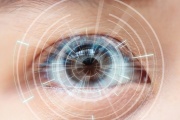An Exciting New Use of Advanced Technology
Modern surgical techniques have completely transformed cataract removal procedures into one of the safest and most predictable of all. Recently, femtosecond lasers that were introduced into refractive surgery techniques like LASIK are being tested by eye surgeons for use in cataract removal.
Femtosecond lasers are extremely short, powerful bursts of light that are used in LASIK procedures. Their use in cataract surgery involves the amount of time spent in surgery; by decreasing the length of time that the surgeon is “inside the eye,” it is thought that the incidence of complications and infections may decrease.
Surgery to remove cataracts has been done for many decades, but for much of that time, the surgery itself, and complications resulting from it often left the patient worse off than they were before.
To understand why the laser is such an important step upward in the removal of cataracts, it is helpful to have an idea of what a cataract is and how the surgeon removes it.
A cataract is located inside the eye, in the crystalline lens, which is found just behind the iris. The clarity and flexibility of the lens is what helps us see clearly, and adjust the focus of the eye from close up to far away, and back again. As we age, the lens becomes thicker and less flexible, making it difficult for us to see well when reading or using a computer.
Along with these changes, we often see a gradual worsening of our distance vision, too, caused by the lens becoming more yellow or brown, which reduces our contrast sensitivity, our color vision perception, and overall clarity.
The visual effects of a cataract are sometimes described as trying to see through a window that has been sandblasted. Because they happen so gradually, patients may not notice that road signs or reading material isn’t as clear as it once was. Eventually, however, the vision is compromised to the point where it causes significant interference with daily life. Symptoms include blurred vision, even with corrective lenses, difficulty driving and changes in color vision.
There is no treatment or cure for cataracts, other than removing them. No dietary supplements, eye exercises or spectacle lenses have ever been shown to be effective.
One huge leap in cataract removal is the intraocular lens (IOL) a tiny optical lens which replaces the patient’s natural lens and allows patients to enjoy vision comparable to their natural vision before they had the cataract. As surgeons became more and more skilled, the incisions used became much smaller, which, in turn, reduced complications from the surgery. The newest IOLs are placed into the lens capsule once the natural lens has been removed; these can be inserted through incisions as small as one millimeter, which don’t even require a single stitch to close them after the surgery.
The actual cataract removal surgery consists of several steps, which are:
- The patient’s eye is numbed using topical and injected anesthetics, which keeps the eye stable and unable to move for the duration of the procedure. The pupil of the eye will be dilated with eye drops to allow access to the lens and its capsule.
- A tiny incision is made at the junction between the clear cornea and the white sclera of the eye.
- The surgeon introduces a miniature scalpel-like instrument, and uses it to cut a circular hole in the capsule, to allow access to the cataract/lens.
- An ultrasonic instrument is then inserted, to break up the lens for removal.
- The fragmented cataract/lens is suctioned out. Any remaining lens material is removed and the capsule polished and left intact.
- The IOL is inserted through the same incision and is placed with care into the lens capsule, which will hold it in place, where it will stay for the remainder of the patient’s lifetime, providing clear, comfortable vision once more.
- The incision is left to seal itself, without stitches which can irritate the eye and eyelids.
- After a short stay in the post-operative area, the patient can return home, and with only a few restrictions, resume his or her usual activities. No patch is required over the eye, leaving the patient with immediately improved vision.
So where does the femtosecond laser come in? In steps two, three and four. The laser pulses are very high-energy, very accurate and very fast. Pulses of this laser energy are tightly focused on the incision area; each pulse takes one ten-trillionth of a second.
First, the incision can be so much more precise, stepping through the cornea and leaving clean surfaces to re-seal after the procedure.
Second, the lens capsule can get an almost perfect circle cut into it, without rough edges or irregularities in shape. This step is also faster.
Third, the laser is used to etch cross-hatching cuts and softens the lens/cataract itself, allowing it to be removed much more quickly and easily. The use of the laser for this step results in reduced time in the eye and reduced heat generated by the ultrasonic equipment by about 50%. There is much less chance for complications resulting from excess heat generated in this step.
The result? Better vision with fewer complications from the surgery, because of the reduced time spent actually doing it.
We should all be very grateful we live in today’s world and not 30 years ago. This surgery and the technology used to perform it have developed and improved that quickly, and we can all look forward to benefiting from these advances.






